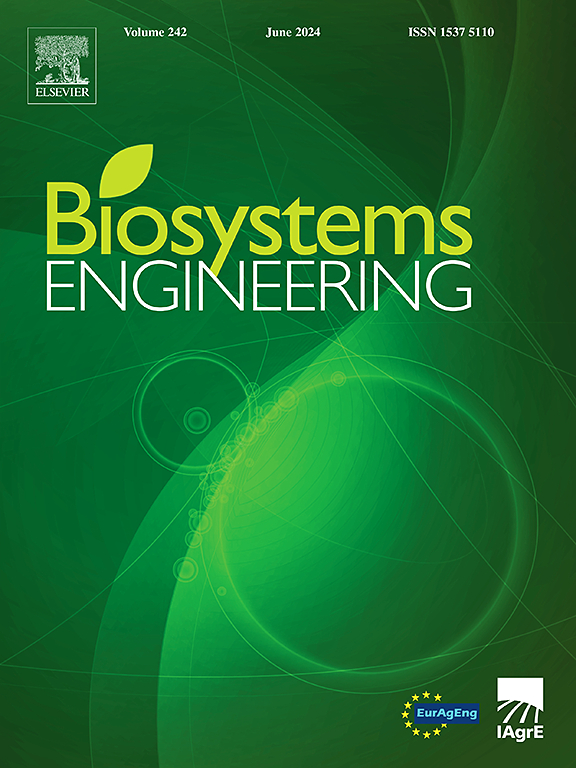Modelling soil water and its uniformity under linear-move sprinkler irrigation
IF 4.4
1区 农林科学
Q1 AGRICULTURAL ENGINEERING
引用次数: 0
Abstract
Crop yield is strongly affected by soil water distribution near the root zone. The redistribution of soil water in sprinkler irrigation results in higher soil water uniformity (CUs) than irrigation uniformity (CUi). A soil water transport model for sprinkler irrigation based on the COMSOL-2D model has been constructed and validated to investigate soil water movement and redistribution. Furthermore, the relationships between CUs, soil hydraulic parameters, and sprinkler irrigation parameters has been analysed. The results showed that 1) the residual distributions of the vertical wetting front (VWF) and soil water content (SWC) were in the ranges of −0.04–0.05 and −0.09–0.10, respectively, with mean values close to 0 and R2 greater than 0.85, indicating that model predictions were reliable; 2) the lower CUi was, the lower CUs, the lower the VWF transport rate, and the higher the chances of deep percolation; 3) the VWF transport rate depended on soil texture (loam > clay loam > silty clay), but CUs was highest for silty clay (76.43 %), medium for clay loam (67.48 %), and lowest for loam (60.36 %); 4) the wetted area and VWF transport distance were positively correlated with soil water at the same moment; and 5) dimensional analysis showed that CUi had the greatest effect on CUs, followed by saturated hydraulic conductivity and water transport time. This study provides a theoretical basis for adequate values of CUi for optimal management of linear-move sprinkler irrigation systems.
线性移动喷灌条件下土壤水分及其均匀性的模拟
作物产量受根区附近土壤水分分布的强烈影响。喷灌土壤水分的再分配导致土壤水分均匀度(CUs)高于灌溉均匀度(CUi)。建立了基于COMSOL-2D模型的喷灌土壤水分运移模型,并对模型进行了验证。此外,还分析了cu与土壤水力参数、喷灌参数之间的关系。结果表明:1)垂直湿润锋(VWF)和土壤含水量(SWC)的剩余分布范围分别为- 0.04 ~ 0.05和- 0.09 ~ 0.10,平均值接近0,R2大于0.85,表明模型预测可靠;2) CUi越低,cu越低,VWF输运速率越低,深渗的可能性越大;3) VWF输运速率与土壤质地(壤土>;粘土壤土;粉质粘土的CUs最高(76.43%),粘土壤土中等(67.48%),壤土最低(60.36%);4)湿润面积、VWF传输距离与土壤水分同时呈显著正相关;5)量纲分析表明,CUi对cu的影响最大,其次是饱和导水率和输水时间。该研究为线性移动喷灌系统的优化管理提供了适当的CUi值的理论依据。
本文章由计算机程序翻译,如有差异,请以英文原文为准。
求助全文
约1分钟内获得全文
求助全文
来源期刊

Biosystems Engineering
农林科学-农业工程
CiteScore
10.60
自引率
7.80%
发文量
239
审稿时长
53 days
期刊介绍:
Biosystems Engineering publishes research in engineering and the physical sciences that represent advances in understanding or modelling of the performance of biological systems for sustainable developments in land use and the environment, agriculture and amenity, bioproduction processes and the food chain. The subject matter of the journal reflects the wide range and interdisciplinary nature of research in engineering for biological systems.
 求助内容:
求助内容: 应助结果提醒方式:
应助结果提醒方式:


